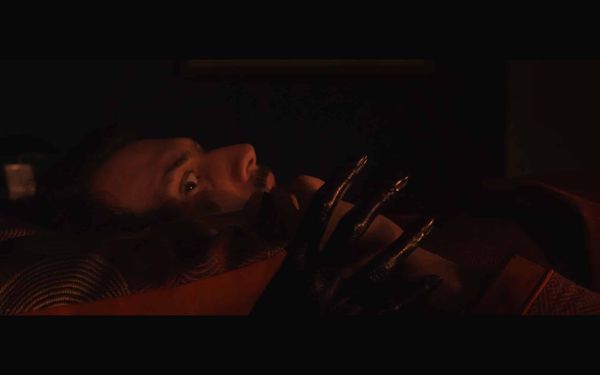 |
| Vinicius Coelho in The Eyes Below |
When I interviewed Alexis Bruchon last year about his début feature, The Woman With Leopard Shoes, a black and white thriller set almost entirely in one room which made quite a splash at Glasgow Frightfest, he told me that he planned to follow up with a similarly pared down project in a different genre. That film, The Eyes Below, is now finished and screening at Fantaspoa in Brazil, so the French filmmaker and I got back in touch to talk about it.
He hand his team had been hoping to go to Fantaspoa, he tells me, but due to Covid, the war in Ukraine and so on, it was just too expensive for them to fly there. They’re still excited that the film made the selection, and Alexis tells me that they have more festival screenings already scheduled for later this year, which they’re looking forward to.
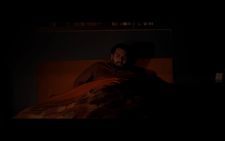 |
| Night terrors |
Discussing the film itself, we begin with the opening shot, in which the camera simply focuses on the bedspread used by the protagonist, Eugene (Vinicius Coelho). The shot is held for long enough that one is drawn into the pattern, tracing and discovering shapes within it. It very much sets the agenda for the rest of the film.
Patterns were very important to the film’s aesthetic, Alexis reveals. He was inspired by Japanese and European paintings, some of which we see in the film: a painting of a man in a bed, and abstract paintings where the focus is on light and movement. ”The opening shot was very important, because it's like a sort of maze and like a spiral. Inside the patterns, and the sheets, the bed is the central part of the theme. So it was very important to focus on it at the beginning.”
Alongside the paintings, we see quite a few books in the room. I have quite a lot of them in my own collection, I note. How did he choose them?
“For some, I choose deliberately,” he says. “For others it was because it's in my private collection. There are some childhood memories. Like there is a magazine called Maison Française, a family magazine from the nineties. You have books about cinema, I think there is a Victor Hugo, Oscar Wilde and some on Japanese art. Not all the books or elements are especially significant for the philosophy of the film but the Gaudi is significant because it's one of the inspirations.”
For me, I say, the books contributed to the ambiguity about the nature of the other presence in Eugene’s room, the owner of the eyes in the film’s title, who comes creeping in under his bedcovers after he’s started to drift off to sleep. Is this a dream, a real life assassin, or some supernatural creature perhaps sent to destroy him?
“The core of the film is that you don’t know if it’s real or just the imagination,” he agrees. “It's also that the film is about image and the purpose of the film was to show how a simple place like your bed could be a surrealist place, so like the first film it starts from a sort of cliché. In The Woman With Leopard Shoes it was the cliché of the robber and also the elements of classic film noir, and in this film it's this very cliché image of what is under the bed when you are a child, when a monster is below the sheets of the bed.
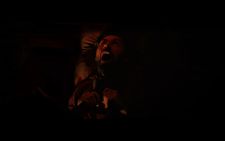 |
| Gasping for air |
“I did a story about a room with this idea, and from the beginning I wanted a very simple theme. Leopard Shoes was a very tricky and very twisty theme with a lot of elements and a lot of information. Here it’s all in sensations and what you feel. It's a theme that you feel and that's hard to clearly understand. That's funny because I screened it to friends and the reactions were very different. The comprehension of the film is different from one person to another. Some are more pragmatic or scientific, and for others it's the images in a nightmare. People perceive different situations.”
Was it something that he was frightened of as a child, that kind of monster under the bed?
“Yes and no,” he says. “I always liked Gothic materials. There’s a bit of the Gothic inside me. For example, I hate summer and sun. I like fog and night and demons. So I was a very happy Gothic child in fact, in my dungeon.” He laughs. “When you are a child, you are happy to be afraid of some things, because you know that it's stories. You can't understand it, but you're excited with that. And I remember when I saw my first horror movies, for example, I was of course very scared, but in the end I was very excited and very happy to see that sort of paintings or books.”
When he embarked on this project, he says, his main focus was still on making more films in the trilogy of which The Woman With Leopard Shoes is part. ”But I had this old project set in a hospital, when a man is lying on the bed after an accident. And in fact, when people go away from his vision, the faces change all the time. Of course, this is a story, but it's a real disease. When you have very poor mental health, you can't recognise the faces of people. And so I started with that, but it was a bit complicated, so basically, I just just looked at some things and thought about this idea of the bed and how to make a film on this sort of theme in a very simple very, with a very simple point of view as a starting point.
“After that I just wrote 20 or 30 pages of script, but very simple. And as usual, I took my pens and I drew a complete storyboard.” He pauses, getting out of his chair and reaching up to a nearby shelf to retrieve a large stack of papers, which he flicks through to show me his working process. This is for a different project, he explains, but he always likes to storyboard in great details even if he doesn’t always have it with him during the shoot.
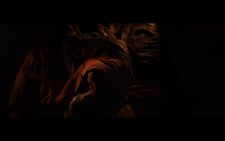 |
| Entangled |
There’s a link in the film to his earlier work, he says, in the form of the letter which is sitting on Eugene’s desk waiting to be delivered the following day, which the mysterious intruder might be there to steal. “It’s just a gimmick but it was a good starting point to good starting point from the thriller to this picture, because it was difficult to know if I wanted to make a totally surreal, fantastic film or shoot a more pragmatic thriller.
“It was a very fun film to make because like the first one we did sets in my parents’ living room. It was perfect. So for example, the fireplace you see was the closet, but there is an actual real fireplace. We build just two walls so it's behind the bed and the wall with the door and after that we built simply everything. We built a crane for this film. It was with just wood and a we built a sort of head which permitted us to go inside the bed and make all the movements that we wanted. And in fact when the camera went inside the bed, I couldn't resist strings. So we put the strings and the sheets, and we could go inside the corridor of sheets. Pauline Morel, who played the woman with leopard shoes, was in charge of costume, so she made the pyjamas and the sheets specially.”
In early scenes, the intruder is covered with dark, oily looking make-up. Wasn’t that a nightmare to control and to clean off all that fabric?
Vinicius was constantly in and out of his pyjamas, which went straight into the washing machine and then back on, saving on the cost of having to make lot of versions, Alexis explains. They used a chocolate-based syrup. “Those scenes were an absolute nightmare. The three of us were covered in chocolate The camera was full of chocolate. It was like the best day for for children!” He laughs. “But we are we are very happy with with the results. The only thing that we regret is with blood because we wanted to give it a more bloody feel, but blood is too expensive for us, because when you add a scene with blood you have to have the same blood for all the scenes, so you need a lot of fabrics, a lot of changes. It was impossible for us.”
Originally, he says, the central character in the film was a woman, but that was a cliché too far.
 |
| The nightmare |
“The storyboarding and scripts were made for a woman. I drew a woman in the bed, but with Pauline, we thought it was a bit cliché to have always the woman in danger with male villain characters, so we thought it was a good thing to reverse the scenes so you have a man frightened in the bed and you have a female villain character. I have a passion for the villain but most of the time it's men, men, men. And in fact, you have not so many female villains, but most of the time, when it’s a woman, she's the best villain. So in the end we changed it, and Pauline was totally okay with that. So finally we said ‘Okay, women put men in a bad situation for a change.’
“I asked my brother [Paul Bruchon, star of The Woman With Leopard Shoes] if he wanted to play a role, but at the time he had just had a baby. My nephew was born at this exact time, so it was actually impossible for him. And in fact, I had a meeting years ago with Pauline and friend of hers, Vinicius, and he was a very nice guy, so I met him. He had been in France with his future husband for two years, I think, but his French was very good. And so I remembered him and I asked him if it was okay for him to make some tests, and he was very good. He has a sort of fragility but at the same time he is very stoic, and it’s a mix which was really good for the role.”
Like Alexis’ previous work, this film is visually very striking. I tell him that I want to talk about colour, and he smiles.
“It was very important, and it was one of the most exciting elements, which was one of the reasons I absolutely wanted to make this film. This thing was very, very important for me because it changed a lot of things I like and I want to make for the future.
“At the beginning the concept was to start with one colour, and during all the film to go to another colour, so you know, you have this very Hollywood thing, orange, and teal. It’s in all the films now. It can be beautiful but it's a bit repetitive. And so, yeah, this film is orange at the beginning until it becomes blue later on. That's part of this little joke. It was wonderful, because I talked about the abstract paintings at the beginning, and the work on colour was to build a sort of abstract film behind the film, a sort of sensation that is something is not right. It's like a fairy tale. Everything is totally artificial.
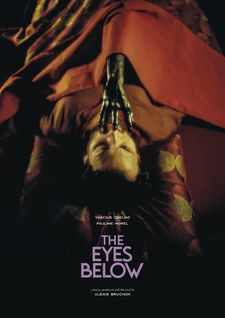 |
| The Eyes Below poster |
“It’s funny because last night I saw a film that I had never seen before, called Lorenzo’s Oil, by George Miller. It's It's struck me because when you are in the house with the parents, it's a very warm. It's a nightmare, but it’s a warm nightmare. And when you are outside, all is grey, etc. It's very simple, but it's very efficient for storytelling. And in our film, I hope it's the same principle, like the pattern at the beginning.”
Alexis composed a strong score for his last film despite having no experience, by taking inspiration from his favourite films, and I see that this time around he has another composer credit.
“It's exactly the same concept,” he says. “I recorded the sound, I recorded some existing music, but I did rebuild all of the sounds. So for example, I took a loop of violin from a film, but after that I multiplied it, I deconstructed it and a lot of elements are in reverse. So it's not just a collage of pre-existing music, because it's integrated. It has very different samples and sounds I recorded.
“One of the concepts is that I did all the soundtracks a little bit in advance of the actual movements. It's difficult when you see the film for the first time, but if you look at it, the music happens a fraction before the actual actions of the main character. So you see the character is not responsible for his action. He's like a puppet. It's just in his mind. It's like a premonition, the music effects the premonition. Things arrive and it's like you're sort of on the railroad. It's like you follow a path. The starting point was just a scream. It's a scream from one of my favourite films, called Onibaba. At one particular moment, a ghost arrived, and she made a sort of...” He imitates the abrupt, rasping sound. “And so it was the starting point of the soundtrack.”
As this film travels round the festival circuit, he’s already busy making more.
“I'm working on two projects. The first one is, I guess, my dream projects. It's a very tiny film but I need some real money to make it. So I started this film seven or eight years ago, the scenario is complete. It's a complete story world, it's very big. I know exactly where I can shoot it, I have the clothes, etc. So I will start to present the film to see if I can raise money or people who are ready to follow us. I will go to the Marché du Cannes during the festival next month. I hope maybe during the festival I can talk to people too. It's very, very tiny film. In fact, there are three main characters and five characters altogether.
“The second project is of course, the next film in the trilogy, and this time, it will be totally outdoor. That's a film not inside my parents’ living room. It will be will be in a car and a field, and there is a twisty concept, so it will be for fun. There will be not just one character but two characters, but never in the same screen. The concept will be the same: almost no dialogue and another work on the colour. It would be very fun to to build on this with just fog and normally one colour and a twisty script. I'm working on it and I will shoot maybe this this fall.”





















